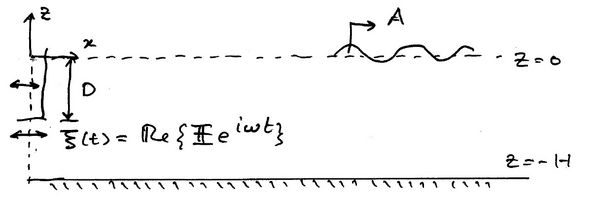Difference between revisions of "Wavemaker Theory"
| Line 138: | Line 138: | ||
[http://www.math.auckland.ac.nz/~meylan/code/dispersion_free_surface.m dispersion_free_surface.m] | [http://www.math.auckland.ac.nz/~meylan/code/dispersion_free_surface.m dispersion_free_surface.m] | ||
to run | to run | ||
| + | |||
----- | ----- | ||
| − | This article is based on the MIT open course notes and the original article can be found | + | This article is based in part on the MIT open course notes and the original article can be found |
[http://ocw.mit.edu/NR/rdonlyres/Mechanical-Engineering/2-24Spring-2002/737E217E-0582-45D5-B1F9-B2ECF977C66E/0/lecture6.pdf here] | [http://ocw.mit.edu/NR/rdonlyres/Mechanical-Engineering/2-24Spring-2002/737E217E-0582-45D5-B1F9-B2ECF977C66E/0/lecture6.pdf here] | ||
Revision as of 10:02, 6 March 2008
Introduction
We will derive the potential in a two-dimensional wavetank due the motion of the wavemaker. The method is based on the Eigenfunction Matching Method. A paddle is undergoing small amplitude horizontal oscillations with displacement
where [math]\displaystyle{ f(z) }[/math] is assumed known. Since the time [math]\displaystyle{ t=0 }[/math] is arbitrary we can assume that [math]\displaystyle{ f(z) }[/math] is real but this is not necessary. Because the oscillations are small the linear equations apply (which will be given formally below). This excitation creates plane progressive waves with amplitude [math]\displaystyle{ A \, }[/math] down the tank. The principal objective of wavemaker theory is to determine [math]\displaystyle{ A \, }[/math] as a function of [math]\displaystyle{ \omega, f(z) \, }[/math] and [math]\displaystyle{ h \, }[/math]. Time-dependent wavemaker theories can also be developed.
Expansion of the solution
In general, the wavemaker displacement at [math]\displaystyle{ x=0\, }[/math] may be written in the form
where [math]\displaystyle{ f(z) \, }[/math] is a known function of [math]\displaystyle{ z \, }[/math]. The standard linear equations apply. Let the total velocity potential be
.
This gives us a Frequency Domain Problem. The water is assumed to have constant finite depth [math]\displaystyle{ h }[/math] and the [math]\displaystyle{ z }[/math]-direction points vertically upward with the water surface at [math]\displaystyle{ z=0 }[/math] and the sea floor at [math]\displaystyle{ z=-h }[/math]. The boundary value problem can therefore be expressed as
[math]\displaystyle{ \Delta\phi=0, \,\, -h\lt z\lt 0, }[/math]
[math]\displaystyle{ \phi_{z}=0, \,\, z=-h, }[/math]
[math]\displaystyle{ \left. \partial_x\phi \right|_{x=0} = \partial_t \xi = f(z). }[/math]
We must also apply the Sommerfeld Radiation Condition as [math]\displaystyle{ x\rightarrow\infty }[/math]. This essentially implies that the only wave at infinity is propagating away.
Separation of variables
We now separate variables and write the potential as
[math]\displaystyle{ \phi(x,z)=\zeta(z)\rho(x) }[/math]
Applying Laplace's equation we obtain
[math]\displaystyle{ \zeta_{zz}+k^{2}\zeta=0. }[/math]
We then use the boundary condition at [math]\displaystyle{ z=-h }[/math] to write
[math]\displaystyle{ \zeta=\cos k(z+h) }[/math]
The boundary condition at the free surface ([math]\displaystyle{ z=0 }[/math]) is
which is the Dispersion Relation for a Free Surface We denote the positive imaginary solution of this equation by [math]\displaystyle{ k_{0} }[/math] and the positive real solutions by [math]\displaystyle{ k_{m} }[/math], [math]\displaystyle{ m\geq1 }[/math]. We define
[math]\displaystyle{ \phi_{m}\left( z\right) =\frac{\cos k_{m}(z+h)}{\cos k_{m}h},\quad m\geq0 }[/math]
as the vertical eigenfunction of the potential in the open water region. From Sturm-Liouville theory the vertical eigenfunctions are orthogonal. They can be normalised to be orthonormal, but this has no advantages for a numerical implementation. It can be shown that
[math]\displaystyle{ \int\nolimits_{-h}^{0}\phi_{m}(z)\phi_{n}(z) d z=A_{n}\delta_{mn} }[/math]
where
[math]\displaystyle{ A_{n}=\frac{1}{2}\left( \frac{\cos k_{n}h\sin k_{m}h+k_{n}h}{k_{n}\cos ^{2}k_{n}h}\right) }[/math]
and
Expansion in Eigenfunctions
The wavemaker velocity potential [math]\displaystyle{ \phi }[/math] can be expressed simply in terms of eigenfunctions
and we can solve for the coefficients by matching at [math]\displaystyle{ x=0 }[/math]
It follows that
Far Field Wave
One of the primary objecives of wavemaker theory is to determine the far-field wave amplitude [math]\displaystyle{ A \, }[/math] ) in terms of [math]\displaystyle{ f(z) }[/math]. The far-field wave component representing progagating waves is given by:
We therefore obtain the complex amplitude of the propagating wave at infinity, namely modulus and phase, in terms of the wave maker displacement [math]\displaystyle{ f(z) }[/math].
For what type of [math]\displaystyle{ f(z) }[/math] are the non-wavelike modes zero? It is easy to verify by virtue of orthogonality that
Unfortunately this is not a "practical" displacement since [math]\displaystyle{ \phi_0 (z) \, }[/math] depends on [math]\displaystyle{ \omega\, }[/math], so one would need to build a flexible paddle.
Matlab Code
A program to calculate the coefficients for the wave maker problems can be found here wavemaker.m
Additional code
This program requires dispersion_free_surface.m to run
This article is based in part on the MIT open course notes and the original article can be found here
Ocean Wave Interaction with Ships and Offshore Energy Systems
